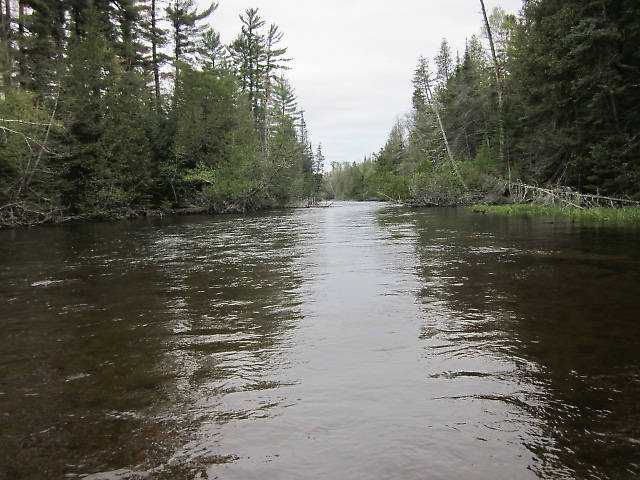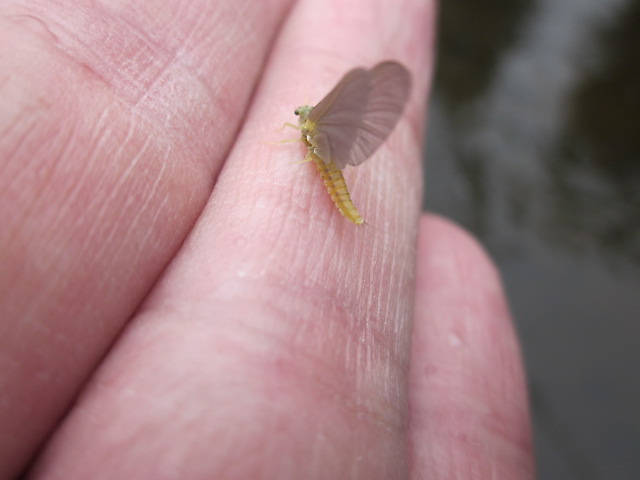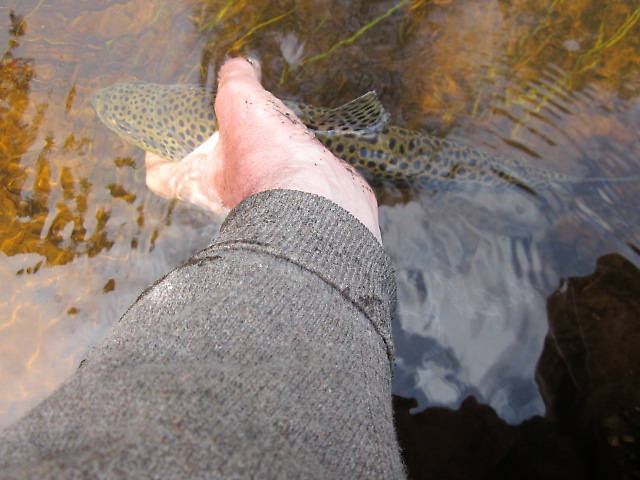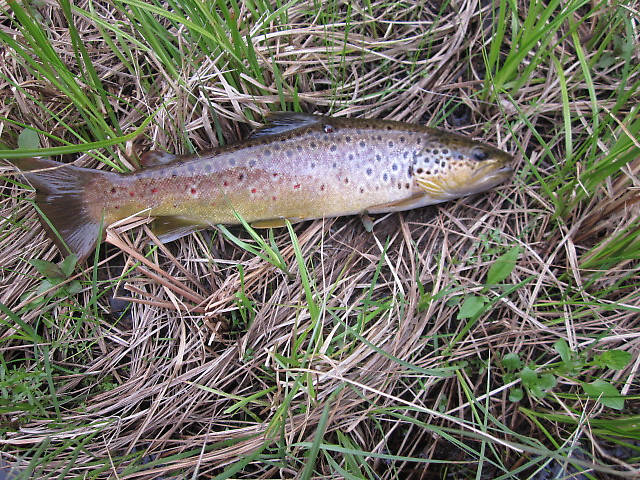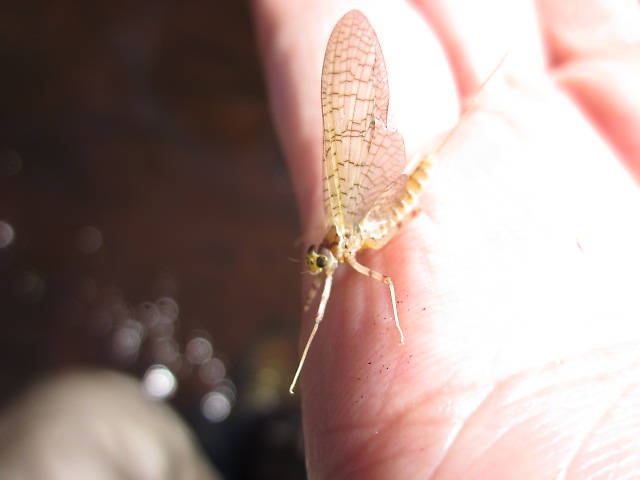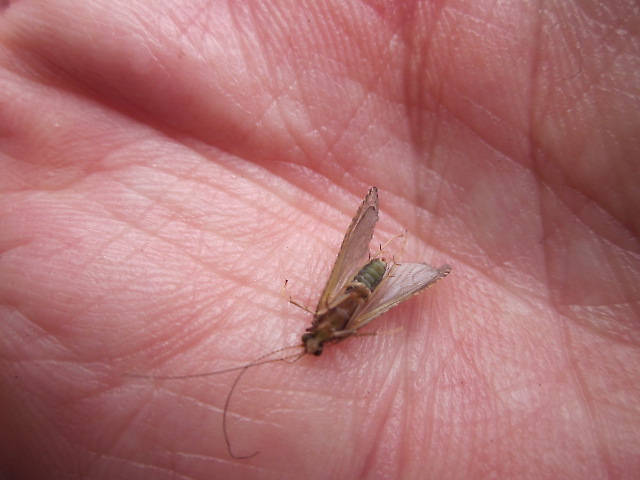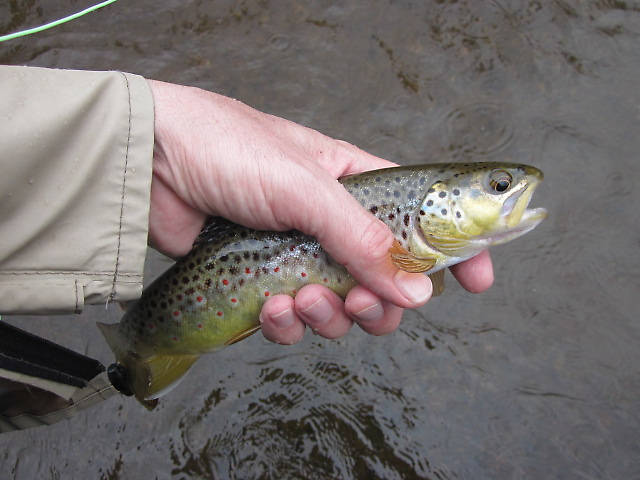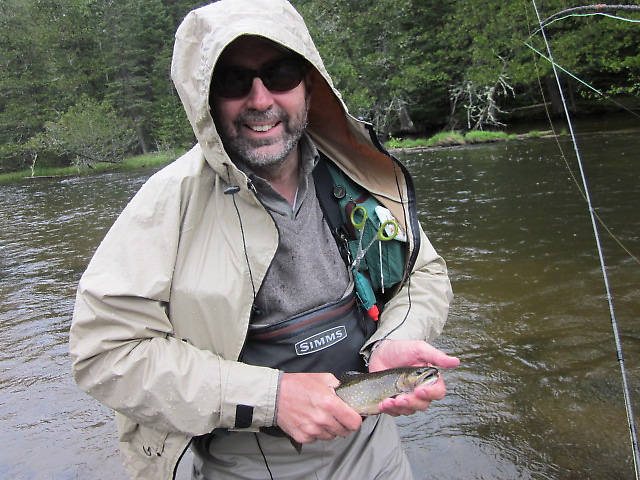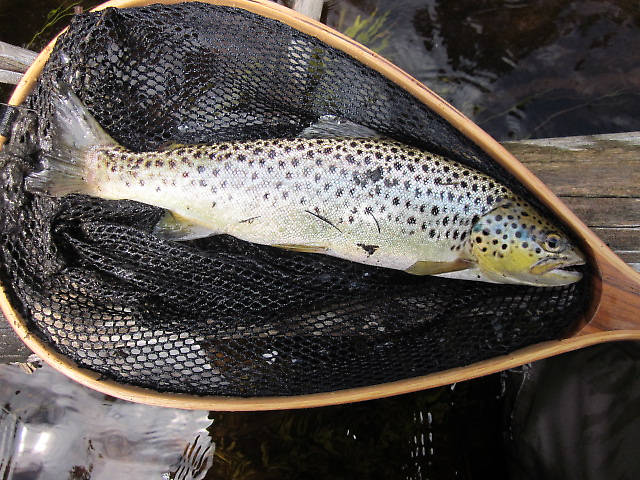Blog & Latest Updates
Fly Fishing Articles
Insects by Common Name


> > A Nod to Mark "Softhackle" Libertone
Oldredbarn has attached these 9 pictures. The message is below.
| Oldredbarn | June 9th, 2011, 11:03 am | |
| Novi, MI Posts: 2608 | This is going to be a little bit fishing report and a tribute to our blog-friend "Softhackle". I was lucky enough to fish the Au Sable this past May from the 18th-29th and I won't run the whole trip by all of you, just one interesting day. I have been nosing around TroutNut for years prior to discovering there was a blog here. Almost from my first post I received wonderful PM's etc from Mark and as most of you know he's a rarity among some of us anglers in that he is a very sharing individual and I have looked forward to any and all of his posts and PM's to me. Over the last couple years we have had a wonderful to-and-fro regarding his obsession with softhackle flies and our discussions have led to me grabbing a few books regarding the topic here and there. He has led me to places for materials, I have copied some of his flies from his web page, and was determined to experiment with them. One of these books I picked up was Nemes', "One Hundred Years of the Softhackle". I had just finished his book on spinners which I think everyone should take a peek at and I was at a show when I spotted this book and picked it up. Now most of you have heard me state here that I'm a dedicated Match-the-Hatcher...Stick with me here on this one for a moment... If I were to give any of you photos of a hundred flies and asked you to pick out 5-10 "Killer" bugs we all would probably choose different ones...This whole madness is subjective after all. In Nemes' book I came across a March Brown pattern that appealed to me and my sense of what might work...It has a bit of an odd twist to it but for the most part it's your run-of-the-mill March Brown wet fly. I tied up a dozen (6 in 14's & 6 in 12's) and tucked them away in my box. Since I have been communicating with Mark over the last few years I've tucked some of his patterns away in my box and they have only made it on the terminal end of my tackle a few times...This is about to change. I had a one pattern day of fishing with this fly and caught fish with it from 11:00am until I quit post 9:00pm...I never used another fly other than I changed the fly as I lost them in fish...I had 12 and as I began to find I had only 4 left I began to panic a bit... It all started at the upstream end of a small island in the Au Sable on the Mainstream looking at what we will call the Brookie Hole...A shallow area we also call the "Nursery" because it's loaded with small brookies and a good spot to figure out if anything is going on and if they are feeding on anything in particular... With my style of fishing I've been taught to toss my shit up on the bank when I arrive at the river and do some reconnoitering before I begin to fish to see what may be going on. I do this even though I have fished the same week on this river since 1991 and one would imagine that I may have an idea or two as to what I might find. I am sitting on the bank and I spot the little caddis I've attached here and some Light Hennies but no fish seem interested. I hear a nice splashy rise back behind the island in a brushy spot where a nice fish no-doubt lives but you would never get a fly over him. I think that one of these caddis has finally pissed off Mr Big and he decided to nail him. Then to my left I see a nice sized mayfly trying to get off the water. He flies up a bit and lands on the water. Takes off again and lands on the water once more...Each time he remains on the water just a little further downstream and as he approaches some structure at the head of the island...SMACK! Gone. I don't like to make long distance fly ID's but my brain said March Brown. I decide, "what the hell! No ones feeding anyway", and on goes the Nemes' March Brown pattern. Except to replace lost flies I fished with it all damn day! Even in the middle of a nice Sulpher hatch that went on most of the day...This blew my mind, but I could not decide to switch because I did not stop catching fish! I actually applied floatant and fished this fly as I would any dry in my box and ran it along logs and on the inside seams on bubble lines etc and caught fish even when it was dragging and at the end of a drag-free-float. As night time approached I was in a spot that is known for it's very big fish and a great spot to be if anything is going on. There is a very sharp bend in the river and everything gets pushed up against the out side bend against these incredibly undercut banks...The structure on that far bank is just piled up. I decide to fish it through though I didn't see any feeding fish. There was a nice gap between overhanging pine trees and a good slick up against the bank where I laid my fly...Bang! The fish decides he wants to run in to the brush...I had cut back to 4x at 6:00pm thank goodness, and was able to horse him away from trouble. He heads down to the bottom of the hole and I felt relieved for the moment...Then I felt that squeaky scrapping feeling in my line only to discover there were dead trees at the bottom of this deep bend...He was under them and in a moment he was free and I was hooked to the underside of the tree...It was way too deep to get my fly and I lost another one...I let out a scream that was heard in Grayling! He would of been the fish of the season had I landed him... Well...What to do? I decided I'm here to fish and re-did my leader and tied on another one and just down in the bend aways I caught the little 12-14" Brown shown on the grassy bank...After it all seemed to shut down and I fished down to the access and headed back up to the car, smile on my face, to cold beers and a sandwich and a grin for that wily old Libertone who I just knew was going to love this story... I am going to leave it at that for now...I am interested in what you all may think about this day of fishing and I'll fill in some blanks if folks are interested. Thanks Mark! Spence | |
| "Even when my best efforts fail it's a satisfying challenge, and that, after all, is the essence of fly fishing." -Chauncy Lively "Envy not the man who lives beside the river, but the man the river flows through." Joseph T Heywood | ||
| Goose | June 9th, 2011, 2:14 pm | |
| Posts: 77 | ||
| PaulRoberts | June 9th, 2011, 4:06 pm | |
| Colorado Posts: 1776 | Gosh those bug pics could have been from my old stomping grounds in NY at this time of year. Sounds like a wonderful day. You had a good 'bug' tied on -good enough to turn some heads. Was it a "little gray bastard" (Humphreys)? Oh...you already said it was a "little brown bastard". :) You can wait for "something to happen" -to tip you off. Sometimes it does, sometimes it doesn't. You can just fish and present to as many eclectic feeders as you can. An LBB may be as good as, (or better than?), any. Reminds me of before I ever attempted to be a "hatch-matcher". I fished either tiny LGBs and LBBs on tiny jigheads on spinning tackle, or wet flies and streamers on fly tackle. There were almost always some willing fish, sometimes a lot. Hatch-matching I see as a specializing, fine-tuning, and worth it if "something is going on" and you can recognize it. It can also cost you fish if that's your only expectation. Fish adjust their expectations everyday. This day may change your expectations some too. But don't expect it to work like magic everyday. Sometimes there's "something going on". I also see it was a cool day in June. Trout metabolisms were likely at high efficiency. They could afford to "play". | |
| Oldredbarn | June 9th, 2011, 5:15 pm | |
| Novi, MI Posts: 2608 | Fish adjust their expectations everyday. Paul, Maybe all the time... I think that all of us anglers that have fished awhile carry around somewhere buried in our heads a reference book of all our experiences a stream...The hard part sometimes is being able to listen to these experiences when they are trying to remind us of similar situations...It can be like a sixth sense or, as you alluded to, lock us in to something that's flat out wrong and waste our time. Hatch matching is usually where I start but I agree with Gonzo that selectivity can be rare and maybe even not a good strategy for a fish and opportunism is more likely where they live. I was watching a Cedar Waxwing and a Baltimore Oriole last night snacking on the berries from my Amelanchier. I was wondering aloud to my wife about why they don't seem in the mood to save something for later. Instead they took every berry that was ripe period...They have competition and aren't guaranteed anything will still be there once they return...So they get it while they can because there may not be "a later". The Browns on the Au Sable are a wild surly lot and are not fond of daylight or straying to far from good feeding spots. They are basically lazy. A good way to fish this river is to "work the wood" as Rusty Gates used to say. We run our fly of choice right up against structure where the Big Boys like to lay and wait for food to come to them. So, they are lying there feeling safe and feed on anything that gets pushed up against the wood they are hiding under...They seldom move and if you are a couple inches out on a pass with your fly you might as well be a mile. These fish are used to many different things getting stuck up against the wood or that may be making an attempt to crawl up and away from the water...They see a variety all the time. They can afford, most of the time, to forget about selectivity...They are in the best spot after all. A few days prior to the one I discribed above I fished an olive stone down the river and placed it right along the wood as close as I could get it (If your fly isn't getting snagged from time-to-time, you are not close enough)and with the best drift I could muster. It was a floating version of what we call the "Mattress Thrasher" (this is usually to cover the Yellow-Throated Stone but mine matched the little olive). I moved fish all day. Rusty had a fly called "The Not" (or the Knot) which was a parachute fly along the lines of a Borcher's that he thought was a fair imitation of a spinner. He thought that fish tucked up against the structure see spinners in one form or another all day and you could basically fish this fly to great success depending on your casting skills all the time. I have heard it called "Head-Hunting" but I prefer to call it "Trying to Raise the Dead". :) The fly I was using (I'll give page numbers tomorrow so folks can look at it) was as follows: Three fibers of pheasant tail tied a little longer than normal length, abdomen dubbed rabbit with fine gold wire rib, thorax dubbed yellowish rabbit, In front of thorax wrap a couple wraps of brown rooster hackle (this is the twist to a softhackle I mentioned in the first post), then a couple wraps of partridge...The rooster helps keep the Pat from collapsing and a bit more flaired out. If I really thought about this fly, and I have :), it could be a fair imitation of the Hendrickson spinner (they were still around the first part of my trip), the March Brown itself or it's spinner...So, as a match-the-hatcher I wasn't too far off except I couldn't get a trout to tell me exactly which hatch I was matching...:) Spence The old time guides have a saying on the Au Sable, "When in doubt, tie on a Borcher's!" If you were to tie the parachute version on, you are probably in the ballpark at least and would be hard pressed to do better IMHO. | |
| "Even when my best efforts fail it's a satisfying challenge, and that, after all, is the essence of fly fishing." -Chauncy Lively "Envy not the man who lives beside the river, but the man the river flows through." Joseph T Heywood | ||
| Adirman | June 9th, 2011, 6:47 pm | |
| Monticello, NY Posts: 504 | ORB; I don't know you but that is an AWESOME post my friend!! Seems to me you stuck with what was working, despite other sensory input indicating you should change to Sulphers(at least at 1 point in time!). Good for you!! That is a hard impulse to resist BTW, changing, changing, changing flies, trying to get the perfect match when you may have had it all along and just didn't give it enough time. Congrats!! Adirman | |
| Jmd123 | June 9th, 2011, 9:06 pm | |
| Oscoda, MI Posts: 2611 | Nice fishies, Spence! I went to the Rifle River myself today, and on waters showing no more than a half-dozen flies over more than four hours caught 7 trout (and lost 2 more) on a #12 Female Adams!! Little guys who I could not hook (must have had 50 hit my fly) were rising all over the place in spite of the conspicuous absence of winged insects (except for the cloud of mosquitos following me around all afternoon...). ????? All fish were browns, two little guys in the 6-7" range and the rest between 9 and 12 inches long. More in a separate post...Again, sounds like a great trip! Jonathon | |
| No matter how big the one you just caught is, there's always a bigger one out there somewhere... | ||
| Softhackle | June 9th, 2011, 10:16 pm | |
Site Editor Wellsville, NYPosts: 540 | Hi Spence, First, let me say I appreciate you sharing with me as well. After all, I believe that it's not always about catching fish, but sharing with others your love of doing it. If I can help others get more enjoyment by sharing some information I've picked up over the years-why not share? That pattern sounds great. I like the idea of using a stiffer hackle behind the softer hackle. Mr. Nemes recognized the importance of keeping the softer hackle from collapsing. Supposedly, the thorax of a soft-hackle does this to some extent, and it's why the thorax is used often. If one studies the history of the North Country fly, it will be discovered that the soft hackles were tied quite perpendicular to the hook shank, very much like a dry, but butted up against the thorax or body of the fly to keep them out. Take a look at this Woodcock and Orange, which I tied in a more tradtional, North Country way: 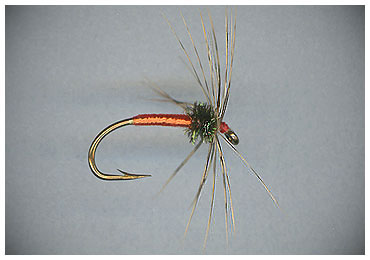 We often forget there are no hard, fast rules in fly fishing for trout-especially for the trout. With this in mind, Leisenring-American Master of the wet fly, broke the rule by varying the stiffness of the hackles he used for the water speed he was fishing, often using cock hackles rather than hen for faster water. Most wet flies are tied using soft hackle like hen or game bird feathers. In doing so, he was able to utilize his fly to its fullest, allowing the fish to actually see the hackle. Leisenring also liked using Cockerel hackle for his flies as well. These are rooster hackle, but the bird has not yet reached full maturity, thus producing a stiffer hackle than hen, yet not stiff enough for dry flies. Many of the modern genetic hen available, today resemble Cockerel. (Somewhere, someone told me they actually are Cockerel.) At any rate, while the fly pattern probably contributed, some, to your wonderful day on the water, I dare say that some of your experience and knowledge played a great role in how successful you were as well. A good pattern in the hands of a good fisherman make for fishing success. There's no doubt in my mind in this instance, that was the case. It's always a pleasure to assist anyone who needs my insight. Thanks for the nod, Spence! Mark | |
| "I have the highest respect for the skilled wet-fly fisherman, as he has mastered an art of very great difficulty." Edward R. Hewitt Flymphs, Soft-hackles and Spiders: http://www.troutnut.com/libstudio/FS&S/index.html | ||
| Jmd123 | June 9th, 2011, 10:41 pm | |
| Oscoda, MI Posts: 2611 | Nice looking fly there Mark! Jonathon | |
| No matter how big the one you just caught is, there's always a bigger one out there somewhere... | ||
| Oldredbarn | June 9th, 2011, 11:34 pm | |
| Novi, MI Posts: 2608 | Oops! Nemes' book is titled, "Two Centuries of Soft-Hackled Flies"...Unfortunately he passed away within the past year, Feb 3rd 2011 at his home in Bozeman. The fly I mentioned and used is listed as Hatching Dun March Brown on page 147. If I can quote, to follow up on Mark's reply, "To tie the hatching duns or emergers, Lawrie suggests two hackles, a wing hackle and a leg hackle. The wing hackle is cut off the bottom of the fly and the leg hackle is cut off the top of the fly., so that "a delicate suggestion of legs of the nymph and of the withdrawn wings of the emerging insect is obtained." p.147 Hook No 12 Wing Hackle: Dark Partridge Leg Hackle: Dark red cock. Body: Medium hare's face spun on orange tying thread, ribbed with fine gold wire. Thorax: Reddish dubbing. Whisks: Three fibres cock pheasant tail. Syl Nemes is discussing in this chapter 27 of his book, "The Book of the Rough Stream Nymph" by William H. Lawrie 1947. I didn't clip the hackles as mentioned, but what a nice fly...I like the idea of using the thorax as a "shoulder" for the softer feathers Mark...Nice bit of info. Mr. Nemes is credited for "re-introducing" us to the older flies and he did a wonderful job...Mark I wanted to thank you for keeping the flame lit, mister! From my perspective there is a great deal of "match-hatching" happening with the old style wet flies...Think dishelved hatching/emerging bugs like mayflies or caddis. Cripples/stillborns are represented as well...And I think the pattern I have mentioned above covers some spinners in a convincing manner. These flies, if they haven't worked for a couple hundred years now, would have long since disappeared. Spence | |
| "Even when my best efforts fail it's a satisfying challenge, and that, after all, is the essence of fly fishing." -Chauncy Lively "Envy not the man who lives beside the river, but the man the river flows through." Joseph T Heywood | ||
| Softhackle | June 10th, 2011, 6:49 am | |
Site Editor Wellsville, NYPosts: 540 | Ah, yes, I'd forgotten about the double hackle, which I've done myself, but not in that manner as Laurie suggests. One can use two hackles to represent both leg and wing. I've used two soft-hackles for this. Leisenring liked hen hackles that had a dark list-that's the center of the hackle fibers-to represent both wing and legs. This would be like badger, furnace and what is known as Greenwell's. Today, Brahma hen capes offer us great hackles with dark lists in various dyed colors. The key to wingless wet fly success is creating the illusion of a living insect. Remember our discussions on Leonard Wright? Well, Leisenring recognized this important "feature" long before Wright did, however Wright applied the idea to dry fly fishing. Mark | |
| "I have the highest respect for the skilled wet-fly fisherman, as he has mastered an art of very great difficulty." Edward R. Hewitt Flymphs, Soft-hackles and Spiders: http://www.troutnut.com/libstudio/FS&S/index.html | ||
| Softhackle | June 10th, 2011, 10:06 am | |
Site Editor Wellsville, NYPosts: 540 | I thought I'd post this sample of using two hackles. It's a Green Drake Emerger pattern I worked on. I was not sure how necessary this pattern is since the drakes hatch very quickly.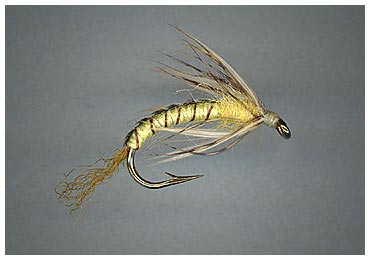 Mark | |
| "I have the highest respect for the skilled wet-fly fisherman, as he has mastered an art of very great difficulty." Edward R. Hewitt Flymphs, Soft-hackles and Spiders: http://www.troutnut.com/libstudio/FS&S/index.html | ||
| TNEAL | June 10th, 2011, 3:59 pm | |
| GRAYLING. MICHIGAN Posts: 278 | Spence, I'm not surprised at your continuning to take fish on the larger fly even while sulphurs were hatching. I've had days when they completely ignored the little bugs and every good fish went for a #12 or even # 10... Tim | |
| Jmd123 | June 10th, 2011, 4:46 pm | |
| Oscoda, MI Posts: 2611 | Thank goodness our Michigan fish are into bigger bugs...my eyes are getting too old to tie up #18s and #20s, let alone follow them on the water... Jonaathon | |
| No matter how big the one you just caught is, there's always a bigger one out there somewhere... | ||
| Oldredbarn | June 10th, 2011, 5:01 pm | |
| Novi, MI Posts: 2608 | Tim, You know I plead guilty to over thinking all this, but I'm having too much fun. I need to get up there and sit on a nice bend some evening with you and your old buddy, Mr. Irascible, and get re-schooled...:) Hell! Maybe we should make him guide us down the river...Wouldn't that be a hoot!? If we had that secretly filmed we could make a million dollars from it! The Drakes are about, as you no-doubt know. I floated with J.C. on the last Saturday in May and he has pretty much given up on me...:) I can still hear him chirping at me from the back of the boat, but at least he's stopped hitting me over-the-head with his poling stick... Have a nice weekend and say a little prayer for your poor old fellow River Rat stuck down by Detroit making a living when he could be fishing... I really can't complain too much...I had 11 days up in May and I only had to call one client...Everything was focused on fishing and the damn river was wearing me out...The water level was tough and every evening I was falling out almost as soon as I placed my head on the pillow...One time I had the hockey game on and woke up in all my clothes as the game was ending... I attended the TU banquet up there and almost bid on a shadow box of old Ernie Borcher's flies...Your buddy had to tie the "Special" to fill it out and it went for $600...I don't know if you heard but an old DNR Quality Fishing sign that fell over and was donated by Steve S went for over $2,000! People will be knocking them down now to hang on their cabin walls. Spence | |
| "Even when my best efforts fail it's a satisfying challenge, and that, after all, is the essence of fly fishing." -Chauncy Lively "Envy not the man who lives beside the river, but the man the river flows through." Joseph T Heywood | ||
| Jmd123 | June 10th, 2011, 5:10 pm | |
| Oscoda, MI Posts: 2611 | Spence, I'm taking "bookings" for the guest room right now. Come on up here with your overabundance of fly boxes and I'll put you on some Rifle and Pine River fishies. Water levels are reasonable and fishies are abundant and eager! Just remember to bring about a gallon or so of mosquito repellent, or remind me and I'll stock up on extra for ya... Jonathon | |
| No matter how big the one you just caught is, there's always a bigger one out there somewhere... | ||
Quick Reply
You have to be logged in to post on the forum. It's this easy:
Related Discussions
| Title | Replies | Last Reply |
| Emergence In Brachycentrus appalachia Caddisfly Adult by Martinlf | 0 | |
| Umbrella hook Western March Brown Dun pattern In Fly Tying by Rgiffin | 0 | |
| Re: florida mayfly nymph imitations In the Mayfly Species Eurylophella temporalis by Homer47 | 2 | Sep 6, 2012 by Sayfu |
| Mosquito Adams In Fly Tying by Mcflyangler | 0 | |
| Re: October Caddis In Dicosmoecus gilvipes Caddisfly Adult by Gutcutter | 2 | Sep 8, 2011 by Sayfu |
| Re: no luck for three months but i finnaly figured out why In General Discussion by Flytyer | 1 | Aug 24, 2006 by Troutnut |
| Re: Trico emergers In the Mayfly Genus Tricorythodes by Bwoklink | 6 | Sep 11, 2020 by Martinlf |
| Re: light & dark cahill nymph patterns In General Discussion by Lastchance | 2 | Feb 18, 2008 by JAD |
| Re: Montana Western March Brown Dun In the Photography Board by Leskorcala | 2 | Apr 10, 2020 by Partsman |
| Re: Emergers In Fly Tying by Fishingguru | 3 | Feb 8, 2008 by Dano |
Troutnut.com is copyright © 2004-2024 Jason
Neuswanger (email Jason). See my FAQ for information about use of my images.
 privacy policy
privacy policy

